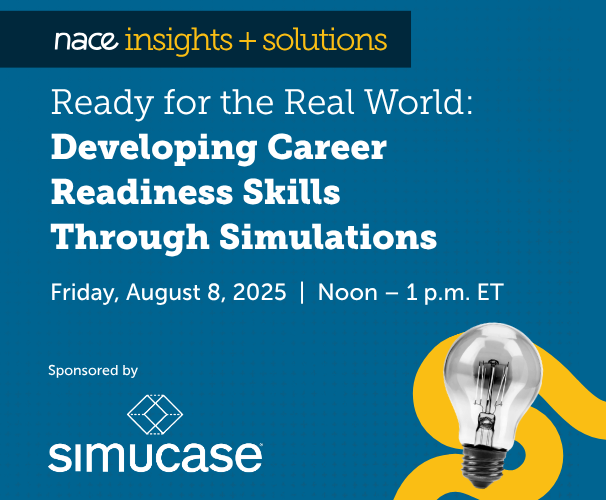Spotlight for Career Services Professionals
In early November 2018, the University of South Florida Sarasota-Manatee (USFSM) flipped the tables on the traditional career fair concept and held its first reverse career fair. The concept proved to be successful.
A reverse career fair differs from a traditional career fair in that, instead of employers setting up displays of their organizations at booths for students to approach, the students were at the tables marketing themselves to recruiters. According to the organizers, theirs was the first reverse career fair held in this region of Florida.
“This format makes students the star of the show,” explains Ben Heins, USFSM’s coordinator of internships and service learning.
“Students still handed out resumes and gave an elevator pitch, but, otherwise, there were no creative constraints. We took off the reins. We didn’t want them to have limits.”
Heins and Bart Stucker, coordinator of orientation and recreation programs who partnered with Heins to create the reverse career fair, were struck by the students’ vision. One folded paper into fortune cookies with facts about himself inside. Some used elaborate tri-fold displays to tell their stories. Others created professional-looking PowerPoint presentations of themselves, their work, and their interests. Tables were adorned with examples of the students’ work and awards they had won (and treats such as homemade cookies).
When interviewing students who were interested in participating, Heins and Stucker told them to start thinking about the design of their table early in the process. Some students were empowered by having unimpeded control. Others, however, were thrown off by it.
To help them, career services held a workshop on the importance of marketing yourself and how to do so effectively. For example, students who are bilingual could have two resumes—one in English and another in Spanish or French—to market this skill.
“The displays were great because many of the students had a line of recruiters waiting to talk to them,” Stucker notes.
“While the recruiters were waiting, they could look over the display and get to know the candidate before meeting face to face with him or her.”
Both the students and the employers praised the level of training the students received prior to the event. In addition to the one-hour workshops that covered pertinent topics such as self-marketing, resume development, and speed networking, Heins and Stucker also conducted approximately 20 one-on-one sessions with students who wanted more guidance on the reverse career fair.
The event far exceeded its goals, which simply were for 20 students to participate and for these students to experience some level of job- and/or internship-search success.
In all, 60 students submitted a resume and went through an interview process. Twenty-six students were chosen and, to match with their career interests, recruiters from more than 60 organizations were selected to participate. During the two-hour reverse career fair, students spoke to an average of 17 employer representatives, while recruiters spoke with an average of 11 students.
Of the 22 student respondents to the post-event survey, 18 were offered at least one job and/or internship. Students accepted 15 offers and, at the time of the survey, two respondents were still awaiting outcomes of their interviews.
“The only criticism we heard from employers was that they want more students, organized by career interests, and a bigger venue, which shows they believe in this format,” Heins says.
“From here, we intend to make it an annual event held jointly with several local colleges. Together, we are planning to hold a regional reverse career fair in spring 2020. In addition, all three colleges of business at the University of South Florida want to hold reverse career fairs just for their students.”
The success of the event speaks to the power of partnership.
“Bart works in student engagement, so he works with students on a minute-to-minute basis and was able to spread the word about our reverse career fair a lot easier,” Heins says.
“Students know Bart and like working with him. Having that strategic partner, especially one who works well with students, was a key element.”
Adds Stucker: “Ben and I work very well together. We have the same energy and work ethic. Finding that in a partnership is important. Students sense that, too. Students buy into ideas, but they buy into the people behind the ideas more.”
To this point, the initiative also received a boost by enlisting the support of USFSM’s student government.
“Partnering with student government from the very beginning really ramped up our numbers,” Heins explains.
“We wanted students in leadership positions to take as much ownership of the reverse career fair as we did. Student government made up its own marketing. Members shared stories on Instagram and Snapchat. Having students—especially leaders—promote it to other students was invaluable.”
Heins says that, although USFSM isn’t the first school to ever hold a reverse career fair, its success was very public, garnering significant media coverage and generating buzz on social media. He and Stucker heard from schools and organizations from New York to Hawaii interested in holding their own reverse career fair. To help others, they have developed the USF Reverse Career Fair Toolkit to share their experience and resources.
“The format is transferable, no matter who you’re working with,” Stucker explains. “Its scalability is a beautiful thing.”
For others considering holding their own reverse career fair, Stucker recommends ensuring students are aware of the transferability of their skills to other career fields. For example, many accounting majors feel that they have to work for an accounting firm.
“The reality is that many industries need accountants,” he points out. “It would be beneficial to hold a workshop prior to the reverse career fair on the transferability of skills.”
Heins adds: “Another thing we would love to do in the future is use technology to provide a more timed structure to the event. This would allow employers to schedule times to meet with students.”
Perhaps the best testament of the success of the USFSM reverse career fair came from the students who answered the following question on the post-event survey: “Would you be willing to come back to future workshops and present?”
“More than 95 percent said they would come back and share their experience during a future workshop,” Stucker says.
“This tells us that they recognize the value of the reverse career fair. Their support is the most important recruitment tool we can have. We feel lucky to have it so early in this process and we’re excited to see where this initiative goes.”







